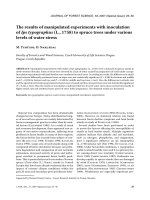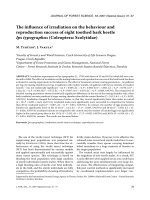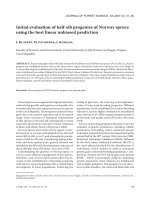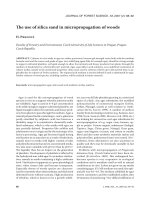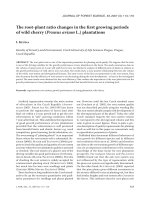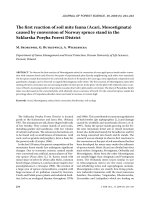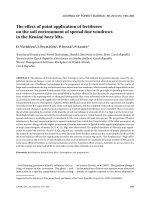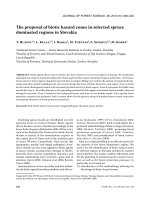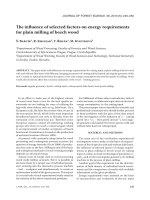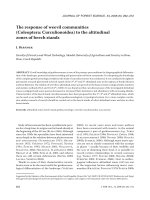Báo cáo lâm nghiệp: "The effects of summer exposure to ozone on the frost hardiness after the vegetation period of Norway and Sitka spruce seedlings" doc
Bạn đang xem bản rút gọn của tài liệu. Xem và tải ngay bản đầy đủ của tài liệu tại đây (328.37 KB, 4 trang )
The
effects
of
summer
exposure
to
ozone
on
the
frost
hardiness
after
the
vegetation
period
of
Norway
and
Sitka
spruce
seedlings
P. W. Lucas
Institute
of
Environmental
and
Biological
Sciences,
(Division
of
Biological
Sciences),
University
of
Lancaster,
Lancaster,
LA1
4YQ.
U.K.
Introduction
No
single
cause
has
been
identified
to
explain
the
decline
of
coniferous
trees
in
some
high-elevation
forests
in
Europe
and
parts
of
the
USA,
but
a
consensus
view
among
researchers
is
that
the
observed
changes
are
associated
with
air
pollutants.
Air
pollutants
are,
however,
only
one
of
a
variety
of
environmental
stresses
which
may
affect
the
physiology
of
trees
and
which
could
predispose
or
incite
damage.
In
those
areas
where
forest
declines
are
occurring,
daily
mean
ozone
concentra-
tions
are
often
above
100
!g-nrr3.
Expo-
sure
to
elevated
concentrations
of
ozone
is
known
to
damage
cell
membranes
(Heath,
1980).
Since
loss
of
membrane
integrity
is
thought
to
be
the
major
cause
of
frost
injury
(Levitt,
1980),
there
are
good
physiological
reasons
to
believe
that
ozone
could
increase
the
sensitivity
of
plants
to
freezing
injury.
The
objectives
of
the
present
study
were
to
investigate
whether
long-term
ex-
posure
to
ozone
during
the
summer
af-
fected
the
frost
hardening
and
deharden-
ing
of
Norway
spruce
(Picea
abies
L.
Karst)
and
Sitka
spruce
(P
sitchensis
[Bong]
Carr)
such
that
their
susceptibility
to
frost
damage
was
increased.
Materials
and
Methods
Ozone
fumigafion
and
growth
measure-
ments
At
the
beginning
of
May
1987,
25
2
yr
old
seed-
lings
of
each
species
were
assigned
randomly
to
each
of
4
large-scale
fumigation
chambers,
described
previously
by
Lucas
et
al.
(1987).
Fumigation
of
thee
seedlings
began
on
1
June
1987
and
continued
until
11
September
1987.
In
two
of
the
chambers,
trees
were
exposed
to
ozone
for
7
h
each
day
(08:00-15:00)
for
5
d
per
wk
at
an
average
hourly
concentration
of
140
μg·m-
3;
the
remaining
chambers
received
charcoal-filtered
air
and
acted
as
controls.
Frost
hardening
and
freezing
tests
At
the
end
of
the
fumigation,
the
trees
remained
in
the
chambers
to
frost
harden
until
lateral
shoot
elongation
had
ended
and
minimum
air
temperatures
had
fallen
below
10°C.
The
first
freezing
test
was
therefore
not
carried
out
until
the
20
October
1987.
On
each
sampling
occasion,
current
year’s
lateral
shoots
were
detached
from
each
of
5
trees
of
each
species
and
from
each
chamber.
Two
shoots,
approximately
4
cm
in
length,
from
each
tree
were
frozen
in
an
unlit
programmable
freezing
cabinet
as
described
by
Lucas
et
al.
(1988).
Separate
batches
of
shoots
were
sub-
jected
to
separate
freezing
tests
in
the
range
-5
to
-25°C,
with
cooling
and
warming
rates
of
5°C
h-
1
and
10°C
h-!,
respectively.
The
preset
tar-
get
temperature
was
held
for
3
h.
After
freezing,
the
middle
portion
of
each
shoot
was
placed
in
a
20
ml
polypropylene
vial
and
15
ml
of
deion-
ised
water
were
added.
The
vial
was
capped,
shaken
and
stored
at
6°C.
Solution
conductivity
was
measured
after
24
h
using
a
platinum
elec-
trode.
The
samples
were
stored
at
6°C
for
a
fur-
ther
5
d
and
the
conductivity
was
again
mea-
sured.
After
this
second
reading,
the
shoots
were
stored
at
6°C
and
after
14
d
scored
for
visual
damage
(0
=
no
damage,
1
=
<50%
damaged,
2
=
>50%
damaged,
3
=
shoot
brown,
assumed
dead).
The
shoots
+
vials
were
then
autoclaved
and
the
total
conductivity
(C-)
of
the
solution
determined.
Based
on
the
assumption
that
the
rate
of
leakage
of electro-
lytes
from
a
detached
shoot
is
controlled
by
dif-
fusion,
the
conductivity
of
the
solution
at
any
time
(C,)
can
be
described
by
a
first-order
reac-
tion
equation:
Ct
=
G
{1
e-’&dquo;).
).
By
logarithmic
transformation
of
the
above
equation
and
substitution
of
the
measured
conductivity
values,
the
rate
of
change
in
conductivity
or
normalised
leakage
rate
(k)
was
calculated.
A
comparison
of
k values
with
visible
damage
showed
for
both
species
of
spruce
that
shoots
with
k
values
>0.35%
h-
I
would
be
killed.
Results
By
the
time
of
the
first
freeze
test
on
20
October
1987
(Fig.
1
the
Norway
spruce
had
hardened
to
a
temperature
of
about
- 19°C,
although
there
was
a
delay
in
hardening
in
those
shoots
that
had
been
exposed
to
ozone.
For
the
Sitka
spruce,
there
was
no
effect
of
pollutant
exposure
on
the
timing
of
frost
hardiness
attained
by
the
shoots
but,
compared
to
the
Norway
shoots
at
this
time,
there
was
a
quite
marked
difference
(approximately
12°C)
in
the
depth
of
hardiness
attained.
Between
20
October
and
24
November,
the
Norway
shoots
hardened
at
a
rate
of
ca
0.3°C
d-
1
compared
to
the
Sitka
which
hardened
at
a
rate
of
ca
0.2°C
d-
1
and
had
acquired
at
least
a
further
5-6°C
of
hardiness.
The
Norway
shoots
may,
how-
ever,
have
hardened
to
much
lower
tem-
peratures,
as
the
minimum
temperature
which
could
be
attained
by
the
freezing
chamber
was
only
-25°C.
For
this
second
freezing
test
and
for
the
tests
made
at
later
dates,
there
were
no
significant
effects
of
ozone
on
the
freezing
sensitivity
of
shoots
from
either
species
of
spruce.
Over
the
period
24
November-20
January,
there
was
no
change
in
the
leak-
age
rate
of
the
Norway
spruce
shoots
and
it
is
probable
that
they
were
hardy
to
temperatures
considerably
in
excess
of
the
minimum
freezing
temperature
shown
(Fig.
2).
In
contrast,
the
Sitka
shoots
had
only
attained
a
further
3°C
of
hardiness
during
this
time.
By
mid-May,
bud
burst
had
occurred
in
all
the
trees
and
a
freezer
test
at
this
time
showed
that
shoots
of
both
species
had
dehardened
to
temperatures
between
-5
and
-10°C
(Fig.
3).
Discussion
and
Conclusions
Exposure
to
ozone
delayed
the
frost
hard-
ening
of
Norway
spruce
shoots
during
mid-autumn.
Similar
results
for
Norway
spruce
have
also
been
observed
by
other
researchers,
both
with
ozone
(Barnes
and
Davison,
1988)
with
S0
2
and
N0
2
in
com-
bination
(Freer-Smith
and
Mansfield,
1987)
and
with
acid
mist
(Cape
et
al.,
1988).
The
results
of
the
present
study,
therefore,
appear
to
support
the
hypothe-
sis
that
air
pollutants
may
predispose
Nor-
way
spruce
trees
to
damage
by
frosts.
For
Sitka
spruce,
however,
there
were
no
effects
of
ozone
on
delayed
frost
hard-
ening
and
the
results
differ
from
those
reported
previously
by
Lucas
et al.
(1988),
in
which
spruce
seedlings
were
exposed
to
a
similar
concentration
of
ozone
using
the
same
fumigation
system.
In
this
case,
although
there
was
no
effect
of
the
pollu-
tant
on
the
attainment
of
deep
winter
hard-
iness,
the
sensitivity
of
detached
shoots
to
autumn
frosts
was
found
to
be
increased.
At
present
it
is
difficult
to
offer
an
explana-
tion
for
the
different
results
between
the
two
experiments,
but
other
environmental
factors
may
be
involved
in
modifying
the
plant’s
response
to
the
ozone.
Acknowledgments
This
work
was
supported
in
part
by
the
UK
Department
of
the
Environment,
the
Commis-
sion
of
the
European
Communities,
the
NE
Forest
Experiment
Station
of
the
USDA
Forest
Service
and
the
US
Environmental
Protection
Agency,
as
part
of
the
National
Acid
Precipita-
tion
Assessment
Program.
References
Barnes
J.D.
&
Davison
A.W.
(1988)
The
influ-
ence
of
ozone
on
the
winter
hardiness
of
Nor-
way
spruce.
New Phytol.
108, 159-166
Cape
J.N.,
Sheppard
L.J.,
Leith
I.D.,
Murray
M.B.,
Deans
J.D.
&
Fowler
D.
(1988)
The
effects
of
acid
mist
on
the
frost
hardiness
of
red
spruce
seedlings.
Aspects
Appl.
Biol.
17,
141-
149
Freer-Smith
P.H.
&
Mansfield
TA.
(1987)
The
combined
effects
of
low
temperature
and
S0
2
+
N0
2
pollution
on
the
new
season’s
growth
and
water
relations
of
Picea
sitchensis.
New Phytot.
1 O6,
225-237
Heath
R.L.
(1980)
Initial
events
in
injury
to
plants
by
air
pollutants.
Annu.
Rev.
Plant
Phy
sioL
31,
395-401
Levitt
J.
(1980)
Responses
of
plants
to
environ-
mental
stresses.
In:
Physiological
Ecology
Series.
(2nd
edn.
Vol.
1)
Chilling,
Freezing
and
High
Temperature
Stresses.
Academic
Press,
New
York,
pp.
254-262
Lucas
P.W.,
Cottam
D.A.
&
Mansfield
TA.
(1987)
A
large-scale
fumigation
system
for
investigating
interactions
between
air
pollution
and
cold
stress
on
plants.
Environ.
Pollut.
43,
15-28
Lucas
P.W.,
Cottam
D.A.,
Sheppard
L.J.
&
Francis
B.J.
(1988)
Growth
responses
and
delayed
winter
hardening
in
Sitka
spruce
fol-
lowing
summer
exposure
to
ozone.
New
Phy-
tol.
108,
495-504
